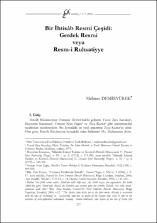Bir İhtisâb resmi çeşidi: gerdek resmi veya resm-i ruhsatiyye
Citation
Demiryürek, M. (2014). Bir İhtisâb resmi çeşidi: gerdek resmi veya resm-i ruhsatiyye. 37, 217-231.Abstract
Osmanlı İmparatorluğu kuruluşunun ilk yıllarından itibaren değişik isimler altında halk- tan vergiler almıştır. XIX. yüzyıl başlarında daha önceki zamanlarda da tahsil edilmiş bulunan “İhtisâb Rüsûmu”nda yeni bir düzenleme yapıldı ve başta İstanbul, İzmir, Edirne ve Kıbrıs olmak üzere imparatorluğun birçok yerinde yürürlüğe konuldu. Temel olarak 1826 yılında Yeniçeri Ocağı’nın kaldırılmasından sonra kurulan Asâkir-i Mansûre-i Muhammediye ordusunun güçlendirilmesi amacıyla yeniden düzenlenen İhtisâb Rüsûmu’nu oluşturan bazı vergiler vardır. Bu çalışmanın amacı İhtisâb Rüsûmu’nu oluşturan vergilerden Gerdek Resmi, Gerdekiyye veya Resm-i Ruhsatiyye adıyla bilinen ve gayrimüslim Osmanlı tebasından talep ve tahsil edilen vergi konusunu ele almak ve Osmanlı İmparatorluğu’nun değişik yerlerine ait Şer’iye Sicilleri ile Başbakanlık Osmanlı Arşivi defter ve belgelerini kaynak olarak kullanarak konuyu ayrıntılarıyla değerlendirmektir. The Ottoman Empire collected a lot of taxes throughout its long history. The İhtisâb Rüsûmu levied after 1826 was one of them. Although this tax was paid mainly by the guilds, in effect it was also paid by non-Muslim Ottoman subjects holding a wedding. The aim of this tax was to support the new army called Asâkir-i Mansûre-i Muhammediye, which replaced Yeniçeri Ocağı in 1826. First this tax was applied in İstanbul, Edirne, İzmir and Cyprus, but then throughout the Ottoman Empire. The aim of this study is to explain how the Gerdek Resmi, Gerdekiyye or Resm-i Ruhsatiyye, one of the taxes of İhtisâb Rüsûmu, was put into practice in some Ottoman cities and its features. The documents or data used are derived principally from the records of the kadı’s court in the Ottoman Empire and the documents and defters in the Ottoman Archives.


















